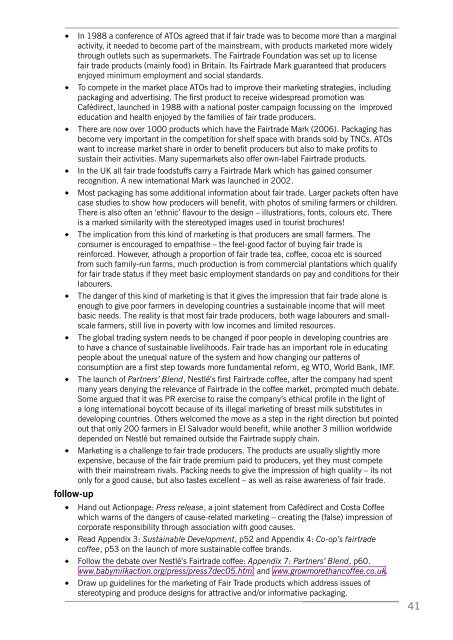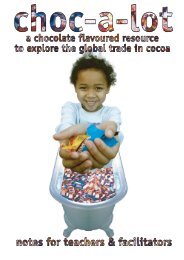Cost of coffee.indd - RISC
Cost of coffee.indd - RISC
Cost of coffee.indd - RISC
You also want an ePaper? Increase the reach of your titles
YUMPU automatically turns print PDFs into web optimized ePapers that Google loves.
◆ In 1988 a conference <strong>of</strong> ATOs agreed that if fair trade was to become more than a marginal<br />
activity, it needed to become part <strong>of</strong> the mainstream, with products marketed more widely<br />
through outlets such as supermarkets. The Fairtrade Foundation was set up to license<br />
fair trade products (mainly food) in Britain. Its Fairtrade Mark guaranteed that producers<br />
enjoyed minimum employment and social standards.<br />
◆ To compete in the market place ATOs had to improve their marketing strategies, including<br />
packaging and advertising. The first product to receive widespread promotion was<br />
Cafédirect, launched in 1988 with a national poster campaign focussing on the improved<br />
education and health enjoyed by the families <strong>of</strong> fair trade producers.<br />
◆ There are now over 1000 products which have the Fairtrade Mark (2006). Packaging has<br />
become very important in the competition for shelf space with brands sold by TNCs. ATOs<br />
want to increase market share in order to benefit producers but also to make pr<strong>of</strong>its to<br />
sustain their activities. Many supermarkets also <strong>of</strong>fer own-label Fairtrade products.<br />
◆ In the UK all fair trade foodstuffs carry a Fairtrade Mark which has gained consumer<br />
recognition. A new international Mark was launched in 2002.<br />
◆ Most packaging has some additional information about fair trade. Larger packets <strong>of</strong>ten have<br />
case studies to show how producers will benefit, with photos <strong>of</strong> smiling farmers or children.<br />
There is also <strong>of</strong>ten an ‘ethnic’ flavour to the design – illustrations, fonts, colours etc. There<br />
is a marked similarity with the stereotyped images used in tourist brochures!<br />
◆ The implication from this kind <strong>of</strong> marketing is that producers are small farmers. The<br />
consumer is encouraged to empathise – the feel-good factor <strong>of</strong> buying fair trade is<br />
reinforced. However, athough a proportion <strong>of</strong> fair trade tea, c<strong>of</strong>fee, cocoa etc is sourced<br />
from such family-run farms, much production is from commercial plantations which qualify<br />
for fair trade status if they meet basic employment standards on pay and conditions for their<br />
labourers.<br />
◆ The danger <strong>of</strong> this kind <strong>of</strong> marketing is that it gives the impression that fair trade alone is<br />
enough to give poor farmers in developing countries a sustainable income that will meet<br />
basic needs. The reality is that most fair trade producers, both wage labourers and smallscale<br />
farmers, still live in poverty with low incomes and limited resources.<br />
◆ The global trading system needs to be changed if poor people in developing countries are<br />
to have a chance <strong>of</strong> sustainable livelihoods. Fair trade has an important role in educating<br />
people about the unequal nature <strong>of</strong> the system and how changing our patterns <strong>of</strong><br />
consumption are a first step towards more fundamental reform, eg WTO, World Bank, IMF.<br />
◆ The launch <strong>of</strong> Partners’ Blend, Nestlé’s first Fairtrade c<strong>of</strong>fee, after the company had spent<br />
many years denying the relevance <strong>of</strong> Fairtrade in the c<strong>of</strong>fee market, prompted much debate.<br />
Some argued that it was PR exercise to raise the company’s ethical pr<strong>of</strong>ile in the light <strong>of</strong><br />
a long international boycott because <strong>of</strong> its illegal marketing <strong>of</strong> breast milk substitutes in<br />
developing countries. Others welcomed the move as a step in the right direction but pointed<br />
out that only 200 farmers in El Salvador would benefit, while another 3 million worldwide<br />
depended on Nestlé but remained outside the Fairtrade supply chain.<br />
◆ Marketing is a challenge to fair trade producers. The products are usually slightly more<br />
expensive, because <strong>of</strong> the fair trade premium paid to producers, yet they must compete<br />
with their mainstream rivals. Packing needs to give the impression <strong>of</strong> high quality – its not<br />
only for a good cause, but also tastes excellent – as well as raise awareness <strong>of</strong> fair trade.<br />
follow-up<br />
◆ Hand out Actionpage: Press release, a joint statement from Cafédirect and <strong>Cost</strong>a C<strong>of</strong>fee<br />
which warns <strong>of</strong> the dangers <strong>of</strong> cause-related marketing – creating the (false) impression <strong>of</strong><br />
corporate responsibility through association with good causes.<br />
◆ Read Appendix 3: Sustainable Development, p52 and Appendix 4: Co-op’s fairtrade<br />
c<strong>of</strong>fee, p53 on the launch <strong>of</strong> more sustainable c<strong>of</strong>fee brands.<br />
◆ Follow the debate over Nestlé’s Fairtrade c<strong>of</strong>fee: Appendix 7: Partners’ Blend, p60.<br />
www.babymilkaction.org/press/press7dec05.html and www.growmorethanc<strong>of</strong>fee.co.uk.<br />
◆ Draw up guidelines for the marketing <strong>of</strong> Fair Trade products which address issues <strong>of</strong><br />
stereotyping and produce designs for attractive and/or informative packaging.<br />
41




